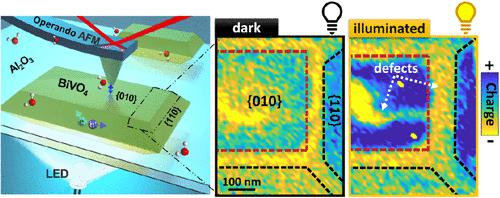当前位置:
X-MOL 学术
›
J. Am. Chem. Soc.
›
论文详情
Our official English website, www.x-mol.net, welcomes your
feedback! (Note: you will need to create a separate account there.)
Nanometer-Resolved Operando Photo-Response of Faceted BiVO4 Semiconductor Nanoparticles
Journal of the American Chemical Society ( IF 14.4 ) Pub Date : 2024-01-12 , DOI: 10.1021/jacs.3c12666 Shaoqiang Su 1 , Igor Siretanu 1 , Dirk van den Ende 1 , Bastian Mei 2 , Guido Mul 2 , Frieder Mugele 1
Journal of the American Chemical Society ( IF 14.4 ) Pub Date : 2024-01-12 , DOI: 10.1021/jacs.3c12666 Shaoqiang Su 1 , Igor Siretanu 1 , Dirk van den Ende 1 , Bastian Mei 2 , Guido Mul 2 , Frieder Mugele 1
Affiliation

|
Photo(electro)catalysis with semiconducting nanoparticles (NPs) is an attractive approach to convert abundant but intermittent renewable electricity into stable chemical fuels. However, our understanding of the microscopic processes governing the performance of the materials has been hampered by the lack of operando characterization techniques with sufficient lateral resolution. Here, we demonstrate that the local surface potentials of NPs of bismuth vanadate (BiVO4) and their response to illumination differ between adjacent facets and depend strongly on the pH of the ambient electrolyte. The isoelectric points of the dominant {010} basal plane and the adjacent {110} side facets differ by 1.5 pH units. Upon illumination, both facets accumulate positive charges and display a maximum surface photoresponse of +55 mV, much stronger than reported in the literature for the surface photo voltage of BiVO4 NPs in air. High resolution images reveal the presence of numerous surface defects ranging from vacancies of a few atoms, to single unit cell steps, to microfacets of variable orientation and degree of disorder. These defects typically carry a highly localized negative surface charge density and display an opposite photoresponse compared to the adjacent facets. Strategies to model and optimize the performance of photocatalyst NPs, therefore, require an understanding of the distribution of surface defects, including the interaction with ambient electrolyte.
中文翻译:

多面 BiVO4 半导体纳米颗粒的纳米分辨原位光响应
使用半导体纳米颗粒 (NP) 进行光(电)催化是一种有吸引力的方法,可以将丰富但间歇性的可再生电力转化为稳定的化学燃料。然而,由于缺乏具有足够横向分辨率的原位表征技术,我们对控制材料性能的微观过程的理解受到了阻碍。在这里,我们证明了钒酸铋 (BiVO4) 的 NP 的局部表面电位及其对照明的响应在相邻刻面之间有所不同,并且在很大程度上取决于环境电解质的 pH 值。主要{010}基平面和相邻的 {110} 侧面的等电点相差 1.5 个 pH 单位。照射后,两个刻面都积累了正电荷,并显示出 +55 mV 的最大表面光响应,比文献中报道的 BiVO4 NP 在空气中的表面光电压强得多。高分辨率图像揭示了许多表面缺陷的存在,从几个原子的空位到单个晶胞阶跃,再到可变取向和无序程度的微观面。这些缺陷通常带有高度局部的负表面电荷密度,并且与相邻刻面相比表现出相反的光响应。因此,模拟和优化光催化剂 NP 性能的策略需要了解表面缺陷的分布,包括与环境电解质的相互作用。
更新日期:2024-01-12
中文翻译:

多面 BiVO4 半导体纳米颗粒的纳米分辨原位光响应
使用半导体纳米颗粒 (NP) 进行光(电)催化是一种有吸引力的方法,可以将丰富但间歇性的可再生电力转化为稳定的化学燃料。然而,由于缺乏具有足够横向分辨率的原位表征技术,我们对控制材料性能的微观过程的理解受到了阻碍。在这里,我们证明了钒酸铋 (BiVO4) 的 NP 的局部表面电位及其对照明的响应在相邻刻面之间有所不同,并且在很大程度上取决于环境电解质的 pH 值。主要{010}基平面和相邻的 {110} 侧面的等电点相差 1.5 个 pH 单位。照射后,两个刻面都积累了正电荷,并显示出 +55 mV 的最大表面光响应,比文献中报道的 BiVO4 NP 在空气中的表面光电压强得多。高分辨率图像揭示了许多表面缺陷的存在,从几个原子的空位到单个晶胞阶跃,再到可变取向和无序程度的微观面。这些缺陷通常带有高度局部的负表面电荷密度,并且与相邻刻面相比表现出相反的光响应。因此,模拟和优化光催化剂 NP 性能的策略需要了解表面缺陷的分布,包括与环境电解质的相互作用。































 京公网安备 11010802027423号
京公网安备 11010802027423号